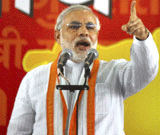New Delhi, Jun 28: Home Minister Amit Shah on Sunday targeted former Congress President Rahul Gandhi, saying he was indulging in "shallow-minded" politics and making statements that make Pakistan and China happy when soldiers are fighting a spirited battle.
Shah said the government is ready for a discussion in Parliament about the situation from 1962 (when India-China war took place) and it is sad that a former president of a party making statements, which are being celebrated in Pakistan and China.
The Home Minister's comments came during an interview with ANI when he was asked about Rahul's "Surrender (Prime Minister Narendra) Modi" remarks while criticising the BJP-led government on India-China border row.
Rahul has been consistent in his criticism of the government on the handling of both Covid-19 situation and India-China border row, which escalated into a "violent face-off" earlier this month in which 20 Indian soldiers were killed.
"Let there be a robust debate in Parliament. Let us have one. Let us discuss from 1962. Nobody is scared of debate. But one should not make a statement that makes Pakistan and China happy when the soldiers are fighting a spirited battle and the government is taking strong steps," he said.
Asked whether India can handle the anti-India propaganda unleashed by Rahul's 'Surrender Modi' hashtag, he said the government is capable of handling it but it is a matter of introspection for the former Congress president and his party that their remarks are being used against the country.
Modi's remarks at an all-party meeting that no one has intruded into Indian territory triggered a controversy with a section arguing that it went against the previous statement of External Affairs Minister S Jaishankar.
Claiming that he could not advise Rahul as it is Congress' job to do so, he said the government has fought Covid-19 well but some people have a twisted way of seeing things. He said India fought well against Covid-19 and the statistics will speak for itself as it is much better compared to the world.
Shah said under Modi's leadership, India is going to win both the battles -- Covid-19 and India-China border row.
The Home Minister also refused to be drawn into a question on whether Chinese soldiers are holding on to Indian territory on the border at present, saying the government is doing enough to address border row with China.
"I don't want to do anything that goes against my primary aim of this interview (to highlight the steps taken to fight Covid-19 pandemic in Delhi) and create headlines that keep citizens further in fear," Shah said.
When pointed out that people are also in panic due to the border situation, he said the government has taken steps to address the situation and at an appropriate time he would make comments, if needed.
Asked about his tweets on Emergency, which was targeted by Congress asking whether there is democracy in the BJP, he countered it saying that BJP has presidents L K Advani followed by Rajnath Singh, Nitin Gadkari, Rajnath again, himself and now J P Nadda.
"After Indira-ji, was there any Congress President from outside Gandhi family? What democracy do they talk about? I did not do any politics during Covid-19. You look at my tweets of the past 10 years. Every June 25, I give a statement," he said.
"Emergency should be remembered by people as it attacked the roots of our democracy. No one should ever forget it. There should be awareness about it. It is not about a party but about the attack on the country's democracy," he said.






Comments
Add new comment